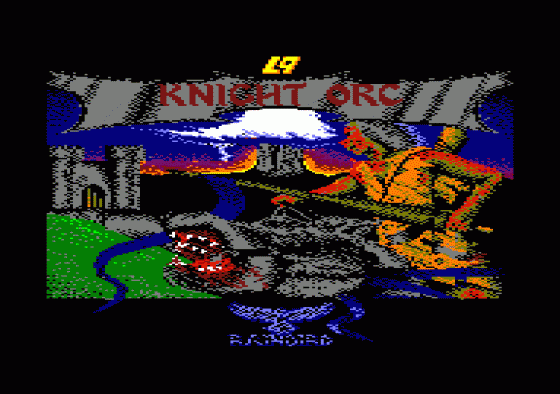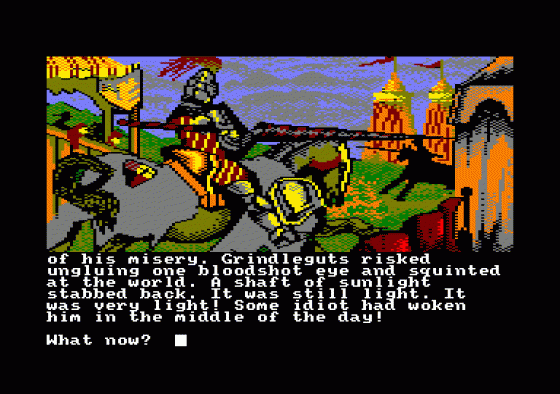
Amstrad Action
 1st January 1988
1st January 1988
Categories: Review: Software
Author: GBH
Publisher: Rainbird
Machine: Amstrad 6128
Published in Amstrad Action #28
Knight Orc
Amstrad owners have been eagerly awaiting this latest Level 9 release tor quite some time now, in particular because it boasts Level 9's new programming system that features powerful interactive character processing Alter a long wait, Knight Orc is just about to hit the shelves. What's it like?
The game comes with a chunky 36-page booklet, giving playing instructions and presenting a short 'novella' about Grindleguts the Orc, a rather disgusting anti-hero whose identity you assume during the game. As usual with Rainbird products the packaging is excellent and cannot be faulted.
Nor can the adventure system Level 9 have come up with Despite the ability of earlier Level 9 parsers to decipher complex commands, games like The Price Of Magik had one glaring omission - the inclusion of convincingly programmed, computer-controlled characters. The Austins have always maintained that 8-bit machines do not offer sufficient memory or processing power for proper character handling, but while they obstinately stuck to their guns, other companies (Infocom in particular and Melbourne House are obvious examples) were introducing characters left, right and centre.

Enter the new system, which not only allows you to address NPCs (Non-Player Characters) but also provides a number of useful high-level commands that can make interaction quite complex. The WAIT command is a good example - simple enough, it allows you (or an NPC) to do nothing for a specified number of game turns. This means that you can orchestrate the actions of different characters, ensuring that they carry out your orders at the right moment. So to kill a particularly vicious troll, you might enter:
DRAGON, WAIT 2, GO NORTH, KILL TROLL
GROK, WAIT 1, GO NORTH, KILL TROLL
GO NORTH, KILL TROLL
...the last command taking you north with the other two and all of you attacking the unfortunate troll at once.

Another very useful command is "FIND". You can use it to find objects in the game, whether these be ordinary objects, objects inside objects, or even other characters. This means you can send other characters off on their own to carry out certain actions and then rendezvous with you at a later date, as in:
GROK, FIND DRAGON, KILL IT, THEN FIND ME
... although in this case Grok is unlikely to return! This command structure enables you to get on with something else while your allies carry out your errands.

Other new high-level commands include "FOLLOW", "GO TO" and "RUN TO". The latter is the same as "GO TO", but does not print object locations as you move to your indicated destination. To all this you can add the usual Level 9 competence in handling your inputs and treating them with wit and dignity throughout the game.
The body blow, however, is that I didn't really get on too well with Knight Orc. First, I'm growing a little tired of Middle Earth-type scenarios. Orcs and trolls were all the vogue when I started playing adventures, but that was a long time ago and since then companies like Activision. Infocom, and Delta 4 have taught me that not everybody in an adventure need have hair between the toes.
Secondly, Knight Orc has a very tortuous scenario. It isn't until later stages of the game that you have any idea at all what's going on. The truth (without giving too much away) is that there are actually *two* games going on simultaneously, but the question of whose playing what is not easy to answer. I like to know where I am in a game, and to have a specific challenge (or challenges) to tackle, otherwise I spend a lot of time wandering around wondering what on earth I should be doing.

However, I should stress that this is a very personal viewpoint - others may relish the uncertainty of it all.
The third reason is a lot more serious. Having introduced characters into the game. Level 9 have gone right over the top and included far too many! If you've ever played MUD on a crowded evening, you'll know what it's like when all the treasure disappears in seconds and you can't move five inches without being challenged, robbed, or otherwise molested.
Knight Orc suffers from this confusion badly. In fact, you'll find the opening stages very similar to playing MUD. The resemblance is quite intentional, but this time you're the mobile and everyone else is human.

The game comes in three parts: Loosed Orc, A Kind Of Magic, and Hordes Of The Mountain King. The first section is simply an introduction to the new system - you have to find several objects that can be tied together to make a rope. If I tell you that one of these can be found simply by typing FIND ROPE you get some idea of the challenge involved. The second two parts are far more challenging, but you can move between them at will so they are in effect one game.
The most difficult puzzles to crack are those involving several characters and one or two of these are very taxing indeed. Otherwise, the game has a slightly empty feel about it - there are a large number of locations but the bulk of them are extremely briefly described, the idea being that you will simply be GOing from one interesting place to another and not paying much attention to what happens in between. Not my cup of tea - I like to wander about viewing the scenery, even if there isn't much to do there.
In conclusion then, a system that promises very well for the future but the game itself presents a rather dated scenario and failed to raise my adrenalin levels as much as I'd hoped.
Magic In Gnome Ranger
The Austins have introduced a novel twist to the usual magic routine in this game - re-usable, multi-purpose potion ingredients.
The idea is that any potion (and you'll find a long list by reading the various books in the alchemist's house) can be concocted from four ingredients. There are a number of different herbs and objects to be found in the game that can be used here and each one has four different attributes: texture, smell (or taste), colour, and form. Thus you might have a smooth, bitter, blue fruit or a rough, sweet, red berry.
Since the potions require not a specific herb but a specific combination of attributes, you may find more than one way of cooking up magic However, the recipes for potions are not always easy to interpret and you may also find yourself having to manage your ingredients carefully in order to have the right ingredients for the right spell at the right time.
High-Level Language
As well as interactive characters, Level 9 have introduced a number of other high-level features into their new system, giving the piayer a particularly flexible and friendly environment to play in.
One of the most useful commands is "FIND". You can use it to find objects in the game, whether these be ordinary objects, objects inside objects, or even other characters. This means you can send other characters off on their own to carry out certain actions and then rendezvous with you at a later date, as in:
GROK, FIND DRAGON, KILL IT, THEN FIND ME
...although in this case Grok is unlikely to return! This command structure enables you to get on with something else while your allies carry out your errands.
Other new high-level commands include "FOLLOW", "GO TO" and "RUN TO". The latter is the same as "GO TO", but does not print object locations as you move to your indicated location.
Disk Or Tape?
The disk version of Knight Orc has some very attractive graphics if you're prepared to shell out the extra £5. They have been "hand-digitised" and Amstrad owners should smirk with glee when I tell them that they look every bit as good (if not better!) than the Atari ST version. Watch out, though - you'll need either a 6128 or a 464/664 plus drive plus ram expansion to run the program.
Tape owners have to make do with text-only, unfortunately. But the tape version will run on any CPC without trouble. To be honest, you don't miss much not having the graphics. They may look good, but you'll be switching them off long before you've finished the game, so you shouldn't pine for them if you're restricted to tape only.













